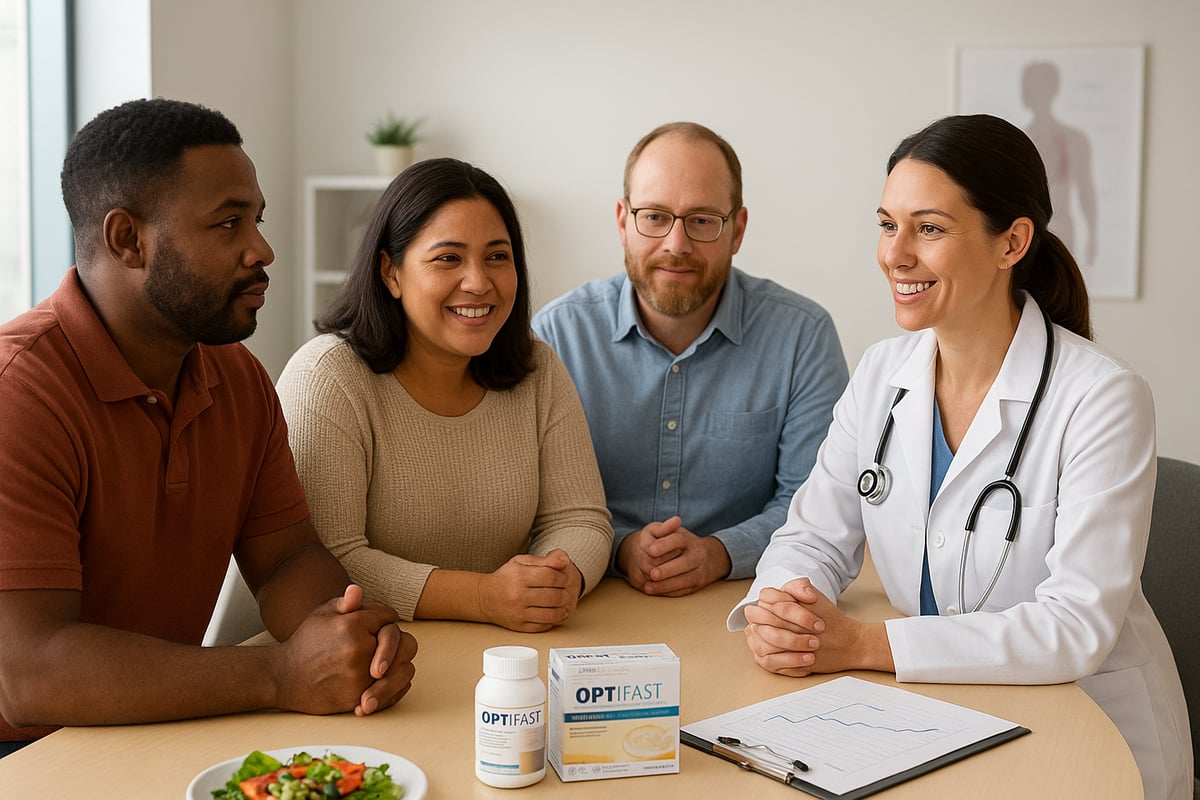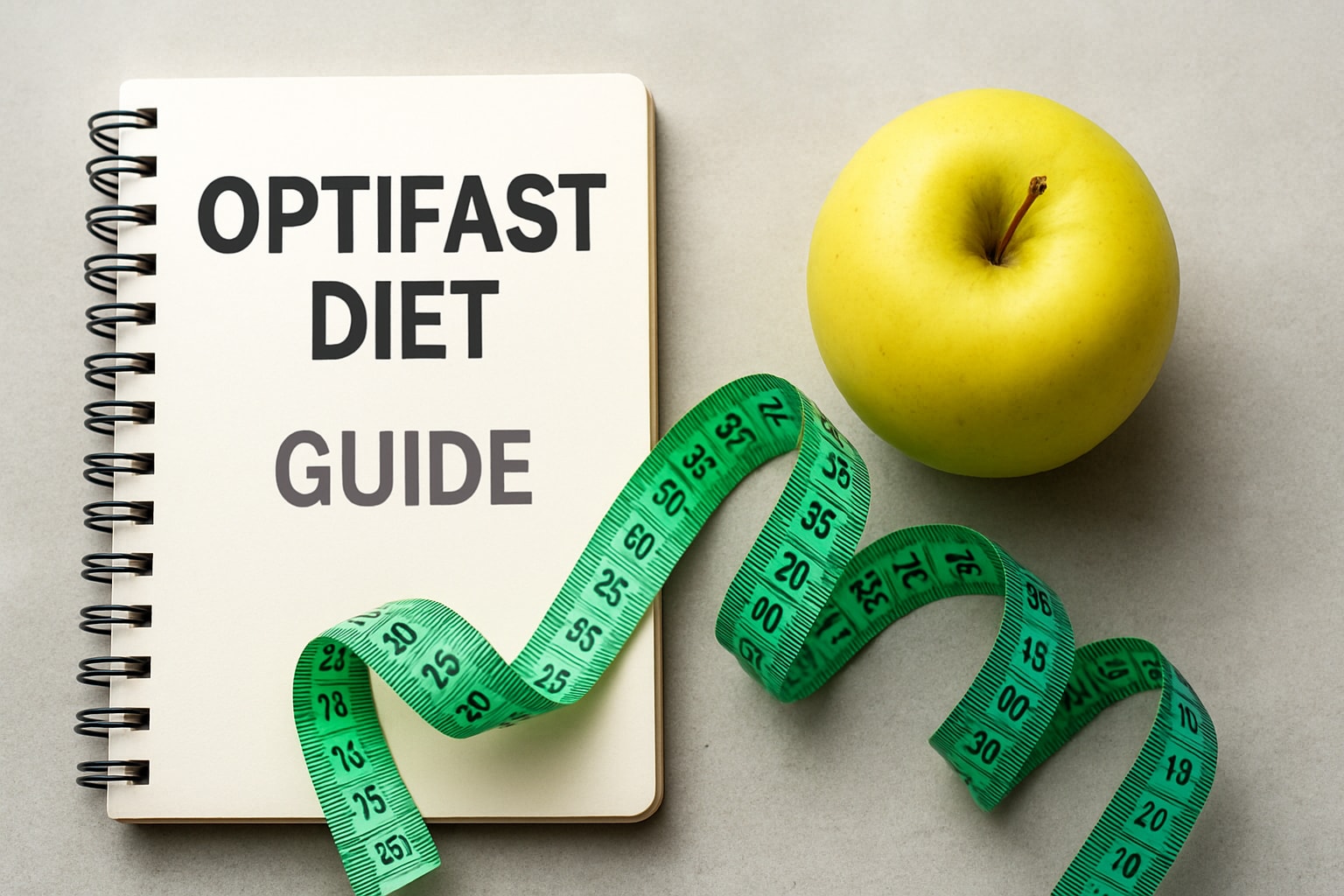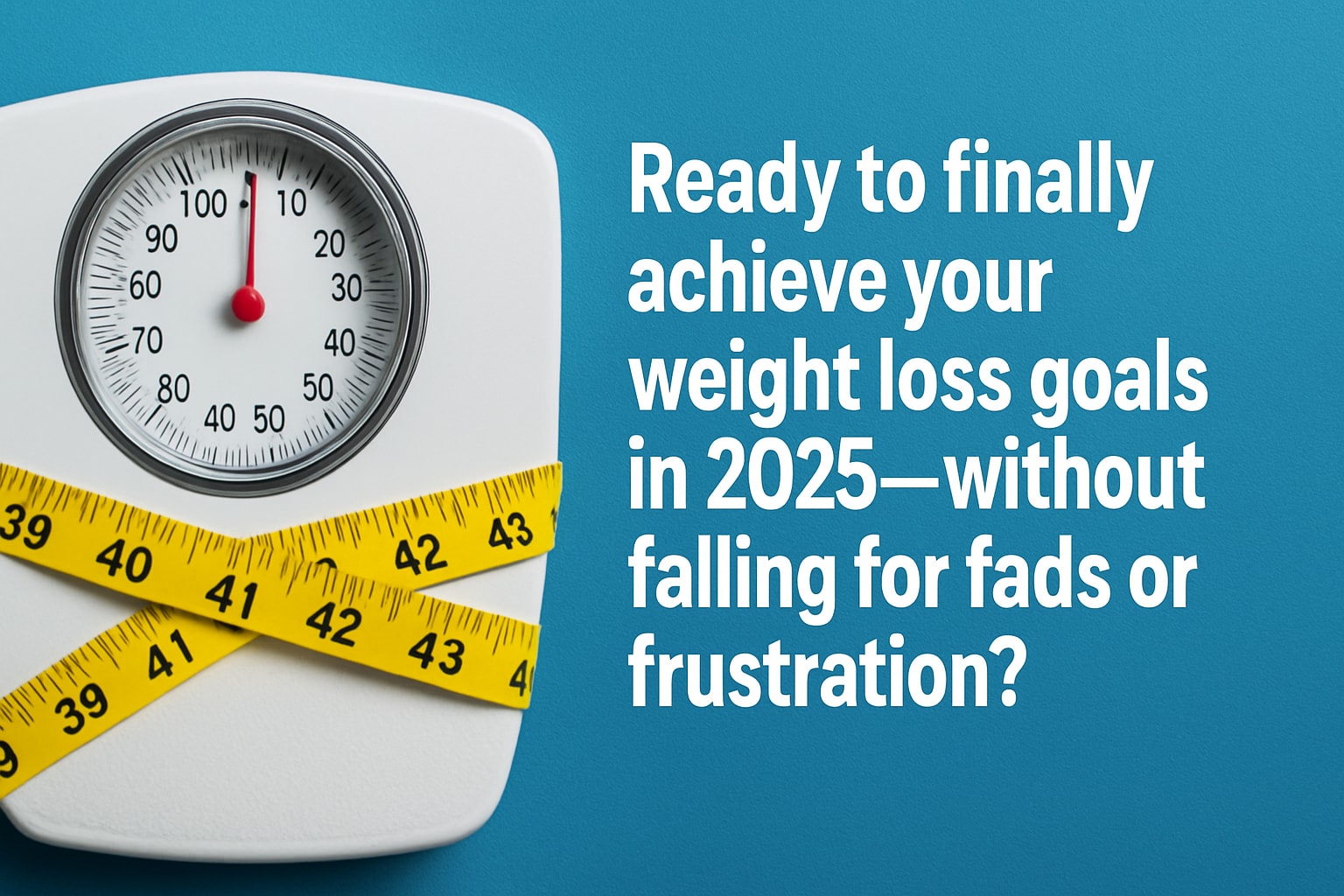Are you searching for a proven, science-backed way to achieve real weight loss in 2025? The optifast diet has helped thousands transform their health under medical supervision, delivering results that last. In this comprehensive guide, you will discover what makes Optifast stand out, how its structured phases work, and why clinical support matters for effective, sustainable change.
Explore the benefits, risks, and inspiring success stories that make the optifast diet a trusted choice for those committed to lasting transformation. Ready to take control of your journey? Start your path to real results today.
Understanding the Optifast Diet: What It Is and How It Works
Curious about how the optifast diet delivers such impressive results? This section explains the science, eligibility, core components, and how optifast diet stands out among meal replacement plans. Let’s break down the essentials so you can see if it’s the right fit for your journey.

The Science Behind Optifast
The optifast diet is a medically supervised, very low-calorie diet (VLCD) program designed for rapid and safe weight loss. It is supported by over 80 clinical studies and decades of use in both medical and surgical settings. Participants consume specially formulated shakes, soups, and bars, typically totaling 800 calories per day, ensuring full nutritional coverage.
These meal replacements provide essential vitamins, minerals, and high-quality protein. This structured approach causes the body to use stored fat for energy, leading to significant fat loss while preserving muscle. For example, a full optifast diet program participant can lose an average of 52 pounds, according to Jefferson Health. When compared to traditional diets, the optifast diet offers consistent, medically monitored results, as highlighted in OPTIFAST program's effectiveness in weight loss.
Explore science-backed approaches for effective weight loss, and see how the optifast diet fits within the broader landscape of weight management.
Who Is Optifast For?
The optifast diet is intended for adults with a BMI of 30 or higher, or a BMI of 27 or more with related conditions such as diabetes or hypertension. Every participant undergoes a personalized medical assessment, ensuring safety and suitability for the program.
It is commonly used as a pre-bariatric surgery tool, helping patients reduce liver size and improve surgical outcomes. However, the optifast diet is not appropriate for pregnant women, children, or individuals with certain chronic diseases. A thorough screening process is the first step, and ongoing medical supervision is mandatory.
Discover who benefits most from medical weight loss programs, and compare eligibility requirements for different approaches.
Core Components of the Optifast Program
The optifast diet features a structured meal plan built around shakes, soups, bars, and optional vegetables. Weekly group meetings provide education and behavioral support, while regular medical checkups track blood work, vital signs, and overall progress.
The program is divided into phases: full meal replacement, gradual food reintroduction, and maintenance. Psychological support is a cornerstone, helping participants address emotional eating and build resilience. Jefferson Health, for example, follows a three-phase plan that emphasizes education and long-term behavioral change.
Key elements include:
- Complete nutrition through meal replacements
- Ongoing group support and education
- Medical monitoring at every stage
- Personalized transition to real foods
- Psychological counseling for lasting results
Learn more about behavioral strategies for sustainable weight loss, or see tips for avoiding weight gain after dieting.
Optifast vs. Other Meal Replacement Diets
The optifast diet stands apart due to its clinical oversight and higher nutritional standards. Unlike over-the-counter shake diets, optifast diet programs are closely supervised by healthcare professionals, ensuring safety and effectiveness.
Participants benefit from long-term support, education, and relapse prevention tools that commercial meal plans often lack. Optifast diet is commonly used in medical and surgical weight management settings, delivering superior outcomes compared to many commercial meal replacement programs.
Key differences include:
- Professional medical supervision
- Comprehensive education and support
- Structured transition and maintenance phases
- Focus on lasting behavioral change
For more on avoiding pitfalls in rapid weight loss, read about common mistakes when losing weight fast.
Ready to explore more? Start your journey with expert weight loss resources, or compare modern weight loss programs to see how optifast diet measures up.
The Three Phases of the Optifast Diet: Step-by-Step Guide
Embarking on the optifast diet means following a structured, medically supervised journey divided into three distinct phases. Each phase is designed to maximize weight loss, support healthy habits, and ensure long-term success. Understanding these stages helps you prepare, set realistic expectations, and get the most from your optifast diet experience.

Phase 1: Full Meal Replacement (6–12 Weeks)
The first phase of the optifast diet is the most intensive, focusing on rapid yet controlled weight loss. Participants consume only optifast products—shakes, soups, and bars—totaling about 800 calories per day. This calorie level is carefully selected to trigger fat loss while maintaining muscle and metabolic health.
Weekly group meetings are a cornerstone of this phase, providing education, accountability, and emotional support. Medical monitoring is frequent, including checks on blood sugar, cholesterol, and blood pressure. Most people lose 15 to 20 percent of their body weight during this stage. According to OPTIFAST's clinical study results, participants saw an average loss of 52 pounds after completing the full program.
Managing hunger and side effects is crucial. Staying hydrated, using behavioral strategies, and connecting with your care team help ease the adjustment. For additional ideas on supporting metabolism during this stage, you can explore metabolism-boosting strategies.
Phase 2: Transition to Healthy Eating (12 Weeks)
After significant weight loss, the second phase of the optifast diet introduces whole foods back into your routine. This transition is gradual, starting with lean proteins, vegetables, and fruits. A registered dietitian will help you create a personalized meal plan that fits your lifestyle and nutritional needs.
Education continues through group sessions, focusing on macronutrients, meal preparation, and navigating restaurants or social events. The goal is to build sustainable habits and reinforce portion control. This phase helps prevent rebound weight gain by teaching you to make healthy choices in real-life situations.
If you encounter plateaus or challenges, your team will help you troubleshoot and adapt your plan. Many participants find that using digital tools for tracking and motivation makes this phase smoother. Additional resources, like expert insights on building healthy habits, can support long-term success.
Phase 3: Maintenance & Long-Term Success (Ongoing)
The maintenance phase is where the optifast diet truly becomes a lifelong strategy. You may continue to use optifast products for meals or snacks, but the main focus shifts to individualized meal planning and healthy lifestyle integration. Ongoing support sessions, often provided at no extra cost, are essential for relapse prevention and continued progress.
During this stage, you will track your progress, set new goals, and celebrate milestones. Relapse prevention is a key topic, and you will learn how to recognize triggers, manage setbacks, and maintain motivation. Many clinics encourage building a strong support system, both in-person and through online communities for weight management.
Physical activity becomes more prominent in this phase, supporting both weight maintenance and overall well-being. For more on sustaining healthy changes, read science-backed tips for weight loss.
Tips for Moving Through Each Phase
Progressing through the optifast diet is easier with the right mindset and support. Here are some practical tips to enhance your journey:
- Attend all education and support sessions for maximum benefit.
- Set realistic goals and celebrate small victories along the way.
- Build a support network with friends, family, and digital health resources.
- Use progress tracking—journals, apps, or photos—to stay motivated.
- Adjust your plan as needed based on medical feedback and personal experiences.
Success stories often highlight the importance of community, accountability, and personalized strategies. For inspiration, discover real-world weight loss journeys and learn about the psychology behind weight loss. You can also find support for overcoming weight loss plateaus as you move forward.
The optifast diet is not just a program, but a pathway to lasting transformation. With commitment, expert guidance, and the right resources, you can achieve—and maintain—your health goals.
Benefits and Results: What to Expect with Optifast
Choosing the optifast diet is a decision backed by real science and tangible outcomes. In this section, you will discover what you can expect in terms of weight loss, health improvements, lifestyle changes, and the timeline for visible results. Whether you are seeking rapid weight reduction or sustainable long-term health, the optifast diet offers measurable benefits that go beyond the scale.

Clinical Outcomes and Health Improvements
The optifast diet has been shown to deliver impressive clinical results. Participants typically lose 15 to 20 percent of their initial body weight, which can mean an average loss of 52 pounds, as reported by Jefferson Health. Improvements extend far beyond weight reduction, with documented decreases of 15 percent in cholesterol, 29 percent in blood sugar, and 10 percent in blood pressure.
These outcomes are especially significant for individuals managing diabetes, heart disease, or hypertension. The optifast diet is also associated with better mobility, enhanced energy, and improved mood. According to OPTIFAST's impact on cardiovascular risk factors, the program is clinically proven to reduce major cardiovascular risks in adults with obesity.
- Reduced risk factors for heart disease
- Improved diabetes control
- Enhanced quality of life
Explore more on effective strategies for boosting metabolism for metabolic support while following the optifast diet.
Psychological and Lifestyle Benefits
The optifast diet is more than a meal plan; it is a comprehensive approach to health. Weekly group sessions provide structured support, helping participants feel less isolated and overwhelmed. Behavioral counseling is a cornerstone, addressing emotional eating and teaching skills to manage triggers.
As confidence grows, many find they are able to build new habits that last. The optifast diet fosters self-motivation and self-awareness, making healthy choices more automatic over time. Group support, both in-person and through online resources, is critical for sustained change.
- Increased motivation and self-esteem
- Development of lifelong healthy habits
- Enhanced emotional well-being
Learn more about the psychology of weight loss and discover how mindset impacts your journey with the optifast diet.
Real-World Success Stories
Thousands have transformed their lives with the optifast diet. Patient case studies demonstrate dramatic weight loss, improved health, and greater quality of life. Many testimonials highlight the ability to keep weight off long-term, thanks to ongoing support and education.
The optifast diet is also widely used as a pre-surgery tool. Patients preparing for bariatric procedures often achieve significant liver shrinkage, making surgery safer and more effective. These real-world stories underscore the program's ability to create lasting change.
- Long-term weight maintenance
- Safer surgical outcomes
- Renewed sense of self
Read more inspiring weight loss journeys and see how others have succeeded with the optifast diet.
How Quickly Will You See Results?
The optifast diet delivers rapid, visible results. Most participants notice significant changes in the first 6 to 12 weeks, including reduced body measurements, improved lab values, and better fitting clothes. Energy levels often rise quickly, contributing to a more active lifestyle.
While the initial phase is intensive, the focus remains on health, not just numbers. The optifast diet helps you achieve safe, steady progress, with ongoing support to prevent plateaus or setbacks. Staying connected with support groups and science-backed resources can help keep your momentum strong.
- Noticeable changes in weeks
- Improved lab results
- Sustainable progress
If you are ready to take the next step, explore expert tips for long-term success and find tools for overcoming plateaus as you continue your optifast diet journey.
Risks, Side Effects, and Medical Considerations
Beginning the optifast diet offers both significant benefits and important considerations. Before starting, it is essential to understand potential risks, side effects, and the necessity of ongoing medical supervision. This section will guide you through what to expect, who should avoid the optifast diet, and how to handle challenges for lasting success.

Common Side Effects and How to Manage Them
When starting the optifast diet, you may experience some common side effects as your body adapts to a lower calorie intake. These can include headaches, fatigue, constipation, and dizziness. Most symptoms are temporary and resolve as your metabolism adjusts.
To minimize discomfort, prioritize hydration and maintain electrolyte balance. Your medical team will help you manage symptoms and ensure you are meeting your nutritional needs. If you feel unusually tired or weak, let your care team know promptly. Remember, regular check-ins are built into the optifast diet program for your safety.
For additional strategies on managing side effects and staying motivated, explore practical advice for overcoming challenges. Support is always available to help you succeed.
Who Should NOT Use Optifast?
The optifast diet is not suitable for everyone. Contraindications include pregnancy, certain chronic illnesses, and active eating disorders. Children and adolescents are generally not candidates due to specific nutritional needs.
Before enrolling, a comprehensive medical assessment is required to ensure safety. Ongoing screening helps identify any emerging health risks. For example, individuals with advanced kidney or liver disease, or unmanaged heart conditions, should avoid this program. If you have diabetes or liver concerns, review OPTIFAST's role in liver health and diabetes remission for more insight.
To learn about alternatives or additional resources, see flexible program options. Consult your healthcare provider before making any dietary changes.
The Importance of Medical Supervision
Medical supervision is a cornerstone of the optifast diet. Unsupervised very low-calorie diets can lead to serious risks, such as nutrient deficiencies and cardiac complications. Your care team will order regular blood work and monitor your vitals to keep your health on track.
Adjustments to medications, especially for diabetes or hypertension, are often necessary as you lose weight. Clinics like Jefferson Health conduct a detailed pre-assessment to tailor the program to your needs. Ongoing medical oversight ensures that you progress safely and effectively.
For a deeper understanding of why supervision matters, read expert insights on healthy weight loss. You can also discover digital tools for tracking your progress and staying accountable.
Addressing Weight Regain and Relapse
Weight regain is a common concern after completing the optifast diet. Causes include reverting to old habits, metabolic adaptation, or emotional triggers. Recognizing these patterns early allows you to implement effective relapse prevention strategies.
Ongoing support is crucial. Attend maintenance sessions and stay connected with your healthcare team. If you notice setbacks, tap into behavioral tools, support groups, or professional counseling. The maintenance phase of the optifast diet is designed to help you sustain your progress.
For more tips on staying motivated and overcoming setbacks, find encouragement for your journey. You can also access articles on the psychology behind weight loss and explore techniques for building long-term healthy habits.
Costs, Accessibility, and How to Get Started in 2025
Understanding the costs, accessibility, and enrollment process is crucial for anyone considering the optifast diet in 2025. This section will guide you through program pricing, how to begin, where to find providers, and valuable alternative resources to support your journey.
Program Costs and What’s Included
The optifast diet is an investment in your health, and understanding the financial commitment helps you plan ahead. Typical program costs range from $175 for a short-term option to over $525 for comprehensive support. These fees usually cover medical assessments, group education sessions, behavioral support, and ongoing monitoring. Meal replacements are often a separate expense, calculated weekly based on your phase.
Insurance coverage for the optifast diet varies by provider and location. Some plans may reimburse part of the program, especially if you have qualifying medical conditions. Major clinics often offer free informational sessions to help you decide if this approach fits your goals. For more details on program inclusions, see an overview of weight loss support options.
How to Join an Optifast Program
Getting started with the optifast diet involves several steps designed to ensure your safety and maximize results. Begin by attending an informational session, where you’ll learn about program structure and expectations. Next, complete a comprehensive medical assessment to confirm eligibility and personalize your plan.
Enrollment requires a commitment to all three structured phases for best outcomes. Many providers now offer both in-person and virtual/telehealth options, increasing accessibility for busy individuals. For a closer look at these steps, explore how to start your weight loss journey. You can also find expert guidance on building healthy habits for sustainable results.
Where to Find Optifast Providers
The optifast diet is available at hospitals, accredited weight loss clinics, and bariatric surgery centers across the country. Start your search by visiting the official Optifast website or consulting online directories. Choosing a provider with a strong clinical track record ensures safe, effective care.
Look for teams that include physicians, dietitians, and behavioral counselors. Many centers support both pre-surgical and non-surgical candidates. For additional guidance, find a qualified provider near you. Taking this step increases your chances of lasting results.
Alternatives and Additional Resources
If you need flexibility, consider shorter-term programs or digital solutions that complement the optifast diet. Support groups, weight management apps, and remote coaching can enhance your progress. Discover neuroscience-based approaches to weight loss or explore science-backed tips for healthy weight management.
For those facing plateaus or seeking motivation, browse practical resources for overcoming challenges. Mindful eating strategies, habit tracking, and community forums also provide valuable support. Learn more about effective and modern weight loss solutions to help you achieve your goals.
Expert Tips, Behavioral Support, and Long-Term Weight Management
Long-term success with the optifast diet relies on more than just meal replacements. It requires a blend of expert strategies, robust support, and sustainable habits. By focusing on behavioral change, leveraging technology, and building a solid support network, you can make healthy weight management a lifelong achievement.
Behavioral Strategies for Lasting Change
The optifast diet emphasizes changing your relationship with food and yourself. Addressing emotional eating and recognizing stress triggers is crucial. Mindful eating helps you tune into hunger cues and avoid mindless snacking.
Setting SMART goals (Specific, Measurable, Achievable, Relevant, Time-bound) keeps progress clear. Track your achievements, celebrate small wins, and use self-compassion when setbacks occur. Positive reinforcement, such as rewarding yourself for healthy choices, strengthens new habits.
Group support is a cornerstone of the optifast diet. Sharing experiences in meetings or online communities encourages accountability and motivation. Explore the psychology of weight loss for deeper insights. You can also see how neuroscience can rewire your eating habits for lasting change.
The Role of Support Systems
A strong support system is vital for success on the optifast diet. Peer support, family involvement, and professional guidance all play unique roles. Group meetings, whether in person or virtual, provide a safe space to share challenges and celebrate progress.
Online communities and forums offer additional encouragement and advice. Access to counselors, dietitians, and medical teams ensures you receive expert input for every stage. Ongoing support reduces the risk of relapse and helps you stay motivated through ups and downs.
Incorporating Technology and Digital Tools
Technology can enhance your optifast diet journey. Use apps to track meals, exercise, and mood. These tools help you stay accountable and spot trends that affect your results.
Telehealth makes remote support and medical check-ins easier to access. Many programs now integrate neuroscience-based strategies for habit change. Try a neuroscience-based app for healthy weight loss or explore digital resources for weight management to boost your progress.
Physical Activity and Lifestyle Integration
Physical activity is a key pillar of the optifast diet, especially as you transition to eating whole foods. Begin with gentle activities like walking, then add strength training and flexibility exercises as your energy improves.
Exercise boosts metabolism, supports mood, and helps maintain weight loss. In Phases 2 and 3, regular activity becomes part of your new lifestyle. Consider using a fitness tracker to monitor your steps and celebrate your achievements.
Overcoming Common Challenges
Every journey with the optifast diet will encounter hurdles. Weight plateaus, dips in motivation, social events, and travel can all challenge your resolve. Planning ahead is essential—prepare healthy snacks, research restaurant menus, and schedule activity into your routine.
When motivation fades, revisit your goals and connect with your support group. Flexible meal options and coping skills can help you handle unexpected events. If challenges persist, seek extra help from your healthcare team or join a support group for ongoing encouragement.
You can also find tips for staying motivated on your journey and learn how to handle setbacks and keep moving forward. Remember, long-term success is built on small, consistent actions.
Additional Reading and Support
Enhance your optifast diet experience with expert resources. Explore more expert advice on weight loss to deepen your understanding. For science-backed strategies, see 7 science-backed tips for healthy weight loss.
Professional guidance tailors your approach and addresses personal challenges. Build a toolkit of digital tools, educational articles, and support networks. This foundation empowers you to achieve and sustain healthy weight management for life.
Now that you have a clearer understanding of the Optifast diet, its phases, and the science behind long term weight loss, you might be wondering where to begin on your own journey toward healthier habits. Sustainable change starts by understanding your unique needs and motivations. If you’re ready to explore a neuroscience based approach that supports mindful eating and habit change without harsh restrictions, I invite you to take the next step. Take a few minutes to reflect on your goals and discover what might work best for you by starting with a personalized quiz.
Start Quizz















